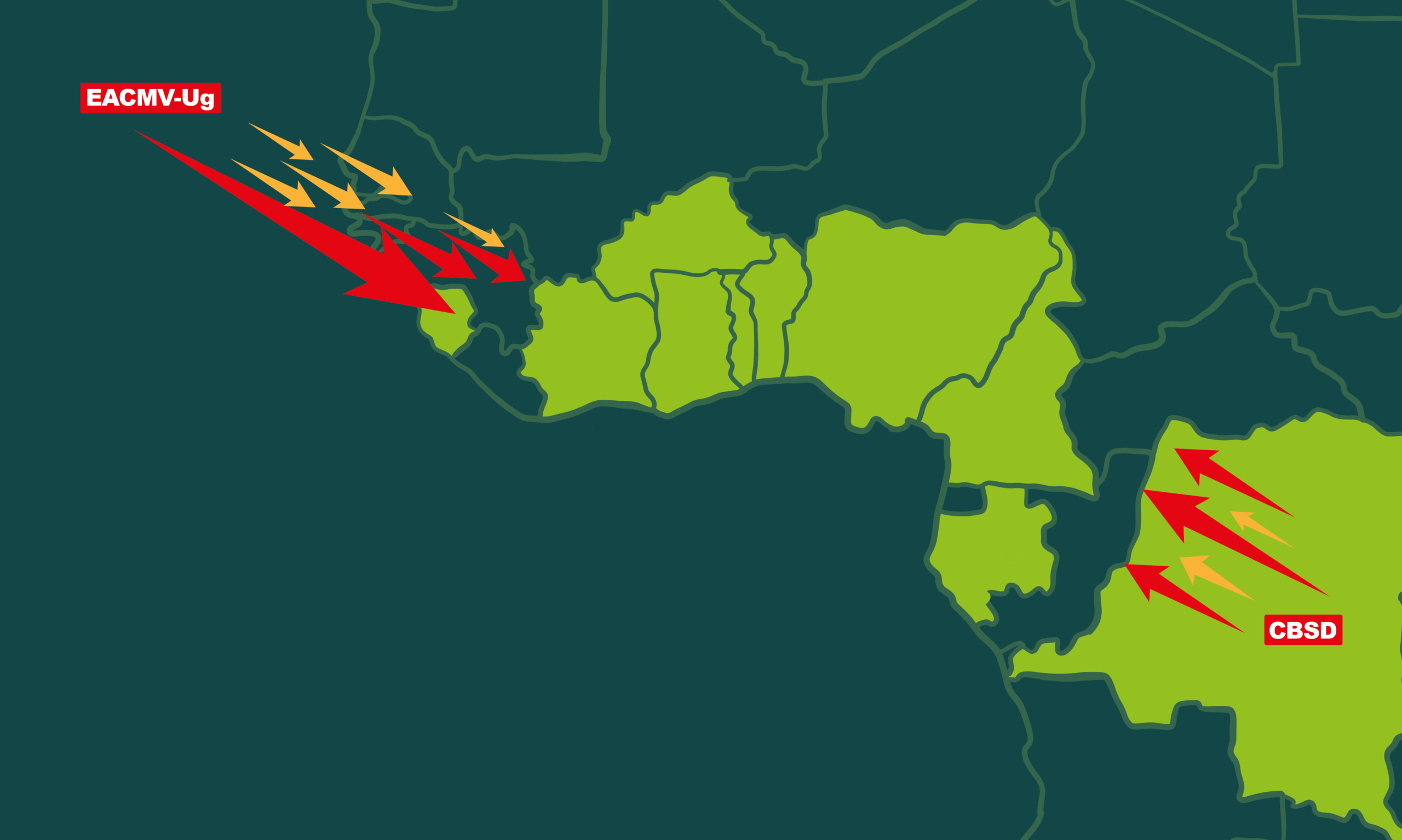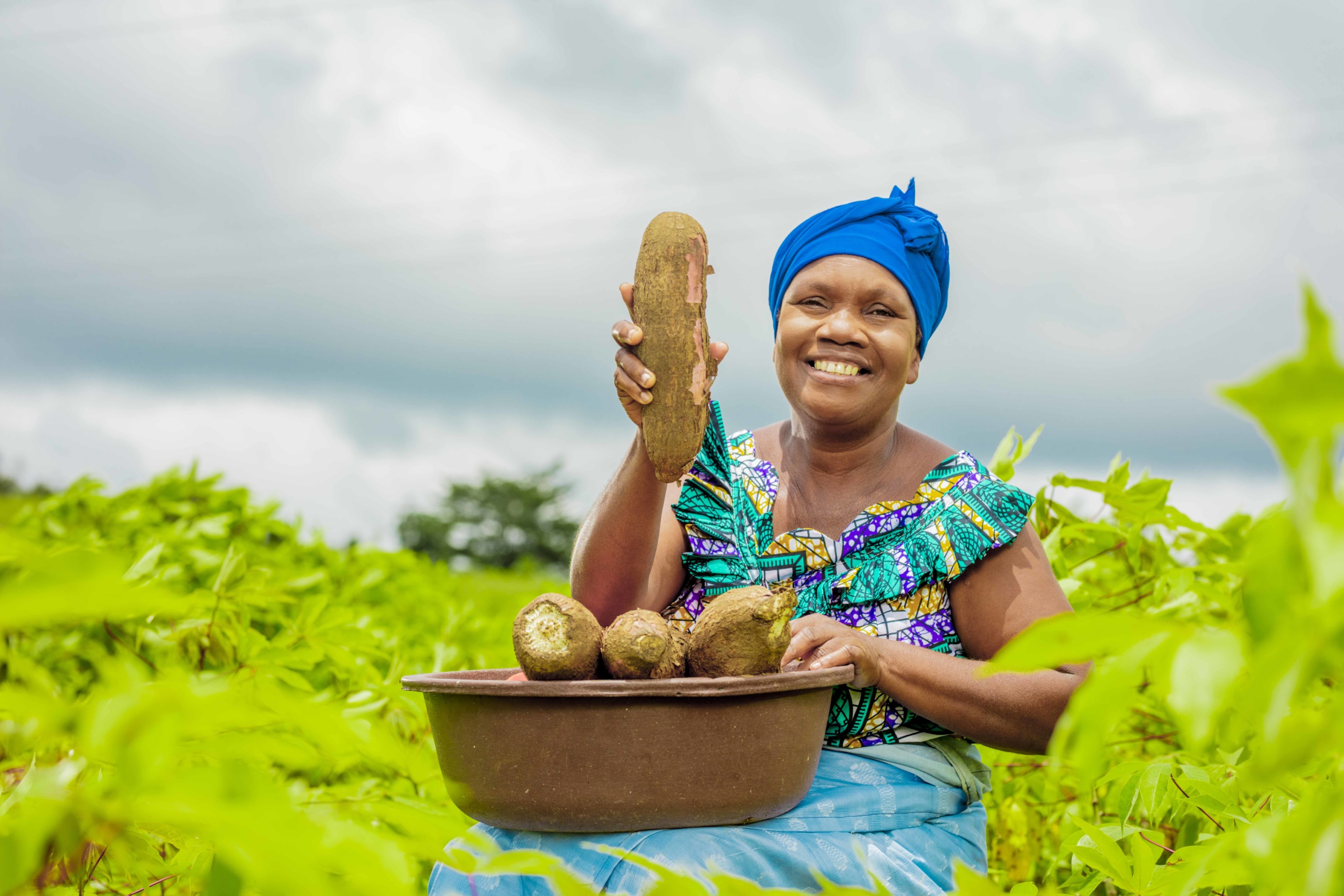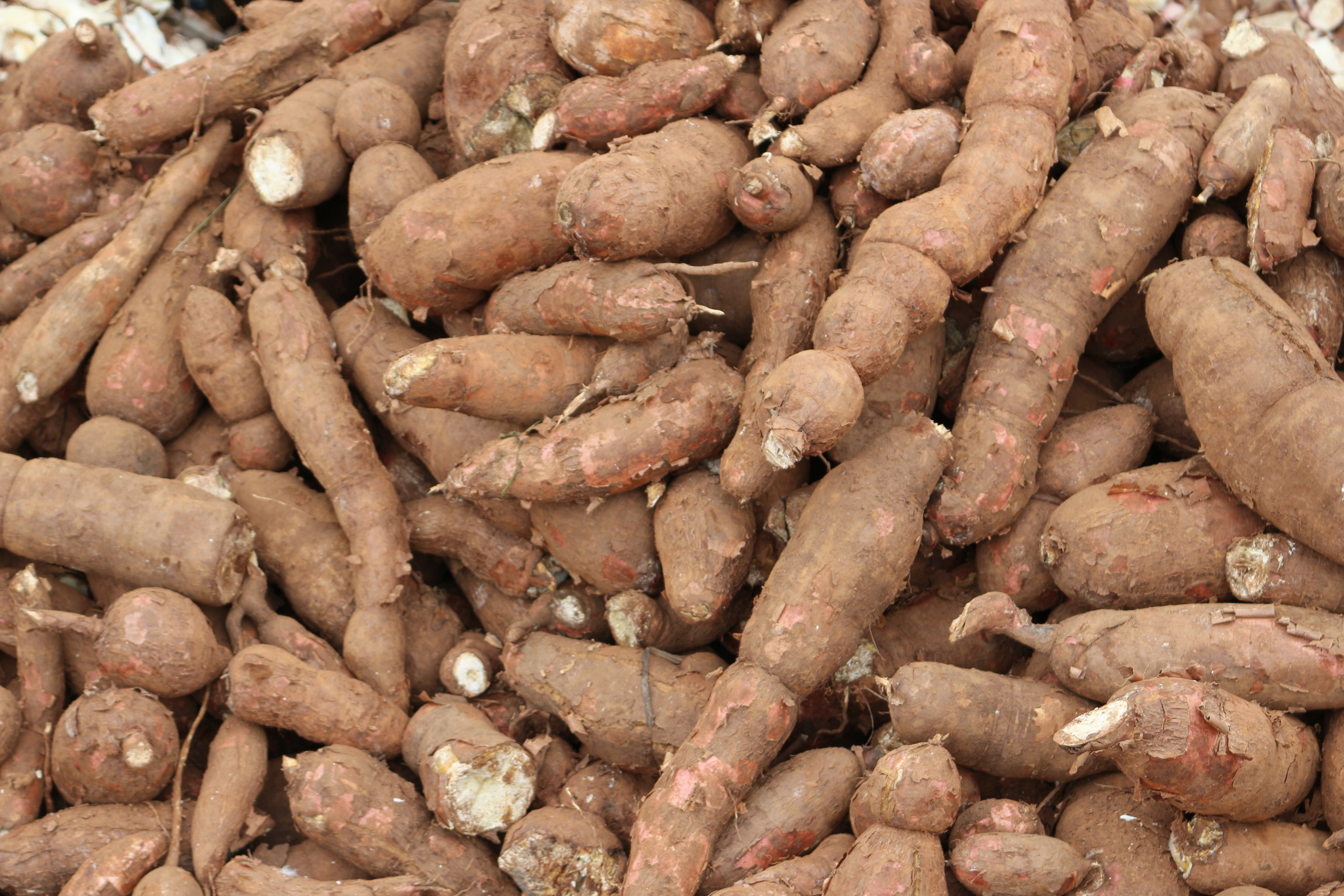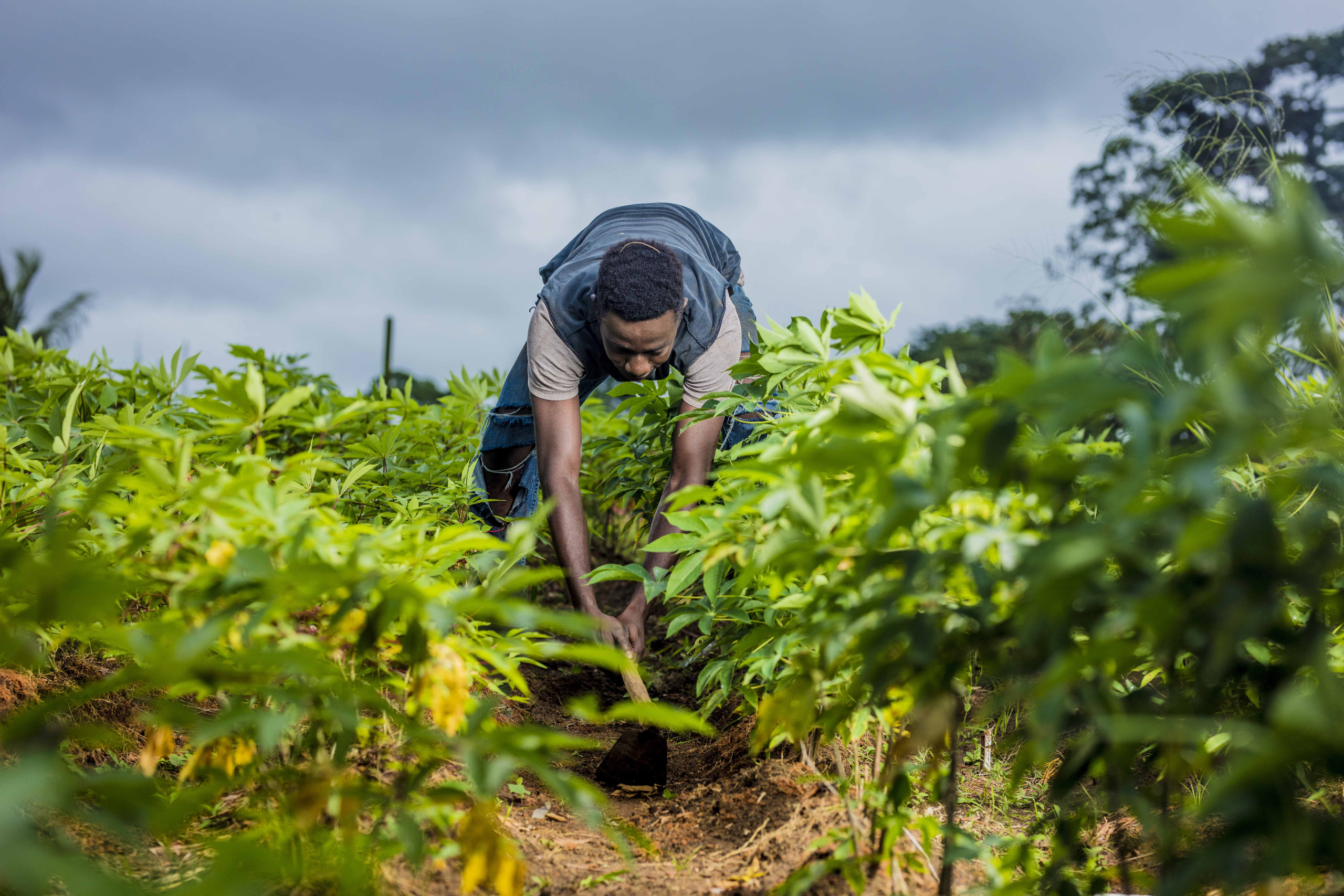Cassava Mosaic Virus Disease in Ghana: Distribution and Spread
Oppong et al., J Plant Physiol Pathol 2021, 9:8
Journal of Plant
Physiology & Pathology
Research Article A SciTechnol Journal
Cassava Mosaic Virus Disease in Ghana: Distribution and Spread
Allen Oppong1*. Ruth Naa A. Prempeh1, Linda Appianimaa Abrokwah1, Esther Afoley Annang1, Esther Agyeman Marfo1, Zipporah Appiah Kubi1, Nana A. O. Danquah1, Augustine Agyekum1, Benedicta Nsiah Frimpong1, Andrews Sarkodie Appiah3, Joseph N.L. Lamptey1, Moses Brandford Mochiah1, Justin S. Pita2
Abstract
Cassava is an important staple crop in most of the tropics, including Ghana. The productivity of the crop is beset with pest and disease attacks. With the emergence of virulent strains of the cassava mosaic virus (CMV), regular surveys are necessary to ascertain the prevalence of CMV and their whitefy vectors in farmers’ felds to help manage CMV disease affecting the crop. Field surveys were conducted in September and October of 2015 and December 2016 to January 2017 using a harmonized sampling protocol developed by the West African Virus Epidemiology (WAVE) for root and tuber projects. Three hundred and ninety-three felds were visited throughout Ghana and 11,760 cassava leaf samples examined. Whitefies were counted on 5 plants/feld. Diseased samples with varying symptoms collected were assayed using PCR and genomic sequencing. Cassava mosaic disease (CMD) symptoms were recorded in about ninety-six percent (96.4%) of felds surveyed with varying severity. These symptoms included leaf mosaic, leaf distortion/twisting, malformation, fliform leaves, stunting and chlorosis. Cultivars with red petiole colour were the most prevalent while those with green petiole colour were the least. No whitefy was found on cultivars with purple and Green petioles while cultivars with reddish-green petioles had highest count of whitefies/plant. The Upper West and Upper East regions had the least amount of whitefies/plant. The Ghanaian isolates clustered with the East African cassava mosaic Cameroon virus (EACMCV) isolates in a cluster analysis. BLASTn analysis of 513 bp fragment of the DNA-B of Ghanaian isolate GH07216 showed 89.9% similarity with EACMCV Ghana isolates and 90.54% identity with the EACMCV-Ivory Coast. Similarly, the Ghanaian isolate GH07216 showed 95.8% nucleotide sequence identity to the EACMCV-Ghana isolate and 94.22% to the EACMV-Ivory Coast isolate. Nucleotide sequences of DNA-A of the Ghanaian isolates were less variable: between 95.90-96.73% when compared to already published sequences to a range of CMG sequences available on the GenBank. The study has updated the existing literature on CMD incidence which can contribute to the development CMD-resistant cassava varieties in Ghana.
Keywords: Manihot esculenta; EACMV-Ivory coast
*Corresponding author: Allen Oppong, CSIR-Crops Research Institute, Kumasi, E-mail: alnopp@yahoo.co.uk
Received: June 29, 2021 Accepted: July 10, 2021 Published: July 17, 2021
Introduction
Cassava is the number one root and tuber crop in Ghana (Figure 1). Te crop is cultivated predominantly in the southern and central parts of Ghana with signifcant production in the middle and northern parts of the country. Te only areas of the country which do not have signifcant production of cassava are the Sudan savannah areas around the Upper East and North East regions (Figure 1). Te estimated total land under cassava production is estimated around 900,000 hectares. In Ghana, over 70% of farmers engage in cassava production, and the sector contributes about 22% of Agricultural GDP [1]. Ghana ranks among the top fve cassava producers in Africa with an annual average production of sixteen million metric tons [1].
Its cultivation and associated businesses along the value chain is a major source of employment for millions of the population. It is a staple food crop in areas where it is cultivated and it is processed into several industrial products such as cassava starch, cassava beer, spray starch, pharmaceutical raw material among several others [2]. In recent times cassava has become an important crop to the socio
cultural life and the economy of Ghana. However, the production of this crop faces several challenges. Tese include dependence on low yielding varieties, poor agronomic practices on the part of farmers and incidence of pests and diseases [3]. Tere are several pests and diseases that afect cassava production, but Cassava Mosaic Disease (CMD) constitutes the most endemic disease of the crop in Ghana [4]. Te disease can cause yield losses of over 90% depending on time of infection and the variety [5,6]. Te disease was frst reported in the country a century ago by Warburg (1894) who described it as ‘leaf curl’ or ‘crinkle’ illness aficting cassava plants” [7, 8]. Several strains of the cassava mosaic virus, the causal agent of CMD, have been reported in Ghana and in other parts of Africa and have been shown to be responsible for severe yield losses [9-15].
To ascertain the current distribution of CMD and the strain diversity of the virus in Ghana it is important that periodic surveys and feld monitoring are conducted. Tis approach can help develop strategies which can curtail the potential damage that new and more virulent strains of the virus could cause to cassava production in the country and beyond.
To this end, two nationwide surveys were conducted to provide baseline data that can be used by breeders and other stakeholders, including modelers, to identify disease hotspot and cold spots for breeding resistant varieties and the multiplication of disease-free planting materials for farmers. Additionally, this would provide data for predicting the rate of spread of cassava mosaic virus in Ghana and West Africa.
Materials and Methods
Field survey
Surveys were conducted throughout the regions indicated in (Figure 1). Tey were carried out in September and October of 2015 and December 2016 to January 2017, using a harmonized sampling protocol developed by the West African Virus Epidemiology (WAVE) for root and tuber project head quartered at the University of Félix Houphouët-Boigny, Abidjan, Côte d’Ivoire. During each survey,
All articles published in Journal of Plant Physiology & Pathology are the property of SciTechnol, and is protected by copyright laws. Copyright © 2021, SciTechnol, All Rights Reserved. International Publisher of Science,
Technology and Medicine
Citation: Oppong A, Prempeh RNA, Abrokwah LA, Annang EA, Marfo EA, et al. (2021) Cassava Mosaic Virus Disease in Ghana: Distribution and Spread. J Plant Physiol Pathol 9:8. 258.
Figure 1: Map of Ghana showing regional boundaries and the agro-ecologies.
coordinates of felds visited were captured using a GPS device. Te minimum distance between two felds where samples were collected was 10 km and in areas where cassava production was sparse, the distance between two felds varied depending on minimum distances felds were encountered. In each feld transect walks along two diagonals were made, and disease incidence and severity were assessed on 15 plants within each transect. Tus, a total of 30 plants were assessed in each feld for disease incidence and severity. Disease incidence was measured as a percentage of number of plants infected per feld based on the sampled plants while disease severity was assessed based on a scale ranging from 1 to 5 as defned by the International Institute of Tropical Agriculture (IITA). Using this scale, 1 represents absence of infection; 2: mild infection; 3: moderate infection; 4: severe infection and 5 represents very severe infection [16]. Data were collected via an electronic device programmed by the University of Cambridge, UK. Te data were then uploaded into a central repository at the University of Cambridge, UK for analysis. From each feld, leaf samples showing symptoms of cassava mosaic virus infection were collected from among the top 5 leaves; these were kept in herbarium pressers and labeled. In addition, stem cuttings of infected plants were also collected and labeled. Te leaf samples were stored at the laboratory under ambient conditions while the stem cuttings were maintained in insect proof screenhouse prior to laboratory analysis. Whitefy Bemisia tabaci vectors were collected using an aspirator from 5 plants/feld and the total number counted and recorded. Te whitefies were preserved in 70% ethanol, labeled and stored at the laboratory in a freezer at 4°C. Te diversity of cassava genotypes encountered on the felds were diferentiated using the leaf petiole colour as most of the farm owners could not readily give the names of the varieties they had planted.
Laboratory diagnostics
Genomic DNA was extracted from samples based on Cetyl Trimethyl Ammonium Bromide (CTAB) method [17].
Polymerase chain reaction (PCR)
PCR was carried out in a 25 µl reaction consisting of the following
reagents: PCR-grade water; 5 µl of 5x standard bufer; 2.5 µl 5% Tween-20; 0.25 µl of 10 mM dNTPs; 0.25 µl each of Forward and Reverse primers; 5 U Taq polymerase and 5 µl of DNA template. (Table 1) contains the list of primers used for the analysis and detection of virus strains.
Termocycling conditions
Amplification conditions included a first PCR cycle comprising denaturation at 94°C for 5 min, annealing of primers at 52°C for 1 min and elongation at 72°C for 2 min. Tis initial amplification cycle was followed by 35 cycles of 1 min at 94°C, 1 min at 52°C and 2 min at 72°C. At the end of the reaction, a final elongation step was achieved at 72°C for 10 min and the reaction held at 4°C.
PCR products were separated by electrophoresis on a 1.5% agarose gel containing ethidium bromide (1 lg⁄10 ml) under a constant current of 100 V. Visualization of the amplified bands under UV light was done using a Vilber Lourmat (InfnityTM) gel documentation imaging system.
Sequencing
Where the expected bands on the agarose gel were not at exactly at the position according to the primer base pair, the recovered PCR products were prepared for sequencing. Sequencing was carried out by GENEWIZ, Inc (South Plainfeld, NJ) using Applied Biosystems Big Dye version 3.1. Te reactions were then run through an Applied Biosystem 3730xl DNA Analyzer for DNA sequencing.
Data analysis
For our analysis, we made use of data-analysis sofware, namely a multi-dimensional data cube referred to, within the WAVE programme as Scriptoria (2021); as the WAVE Cube. Tis tool enabled us to interrogate and view our survey data from diferent perspectives to present our extracted results as tables and graphics.
Sequence analysis
Te sequence data was analysed by frst checking the
Volume 9 • Issue 8 • 1000258 • Page 2 of 9 •
Citation: Oppong A, Prempeh RNA, Abrokwah LA, Annang EA, Marfo EA, et al. (2021) Cassava Mosaic Virus Disease in Ghana: Distribution and Spread. J Plant Physiol Pathol 9:8. 258.
Table 1: Primers used in this study to amplify DNA from cassava samples collected during disease survey.
| Primer Name | Sequences (5’ to 3’) | Virus Species | Product Size (bp) |
| JSP001F/
JSP002R |
ATGTCGAAGCGACCAGGAGAT
TGTTTATTAATTGCCAATACT |
ACMV | ̴ 770 |
| JSP001F | ATGTCGGAAGCGACCAGGAGAT | EACMV | ̴ 770 |
| JSP003R | CCTTTATTAATTTGTCACTGC | EACMV | |
| CMBRep/F | CRTCAATGACGTTGTACCA | ACMV | 368 |
| ACMVRep/R | CAGCGGMAGTAAGTCMGA | ACMV | |
| CMBCP/F | GKCGAAGCGACCAGGAGAT | ACMV | 650 |
| ACMVCP/R | CCCTGYCTCCTGATGATTATA | ACMV | |
| ACMV-AL1/F | GCGGAATCCCTAACATTATC | ACMV | 1000 |
| ACMV-ARO/R | GCTCGTATGTATCCTCTAAGGCCTG | ACMV | |
| UV-AL1/F1 | TGTCTTCTGGGACTTGTGTG | EACMV | 1600 |
| UV-AL1/R1 | AACCTATCCCCGATGCTCAT | EACMV | |
| UV-AL1/F2 | GTAATTGGGAAAGGGCCTCT | EACMV | 1000 |
| UV-CP/R | GTTACGGAGCAACATGCAAT | EACMV | |
| UV-AL1/F1 | TGTCTTCTGGGACTTGTGTG | EACMV-UG | 1600 |
| ACMV-CP/R3 | TGCCTCCTGATGATTATATGTC | EACMV-UG | |
| CMBCP/F | GKCGAAGCGACCAGGAGAT | EACMV-UG | 1000 |
| EACMV-UG/R | CGCCTAAGCAAGGAATGGCGT | EACMV-UG | |
| ACMVB1F | TCGGGAGTGATACATGCGAAGGC | ACMV | 628 |
| ACMVB2R | GGCTACACCAGCTACCTGAAGCT | ACMV | |
| VNF031/F | GGATACAGATAGGGTTCCCAC | EACMV | ≈ 560 |
| VNF032/R | GACGAGGACAAGAATTCCAAT | EACMV | |
| EAB555/F | TACATCGGCCTTTGAGTCGCATGG | EACMV | 544-560 |
| EAB555/R | CTTATTAACGCCTATATAAACACC | EACMV |
chromatograms manually to avoid base miscalls and then trimmed of low-quality sequences at the 5′ and 3′ ends. Te forward and reverse sequences were compared to ensure complete homology. Te sequences were then edited, aligned and compared with other published isolates using Geneious 8.0 (Biomatters), ClustalW [18] BLAST [19]. Te nucleotide sequences derived from each of the CMG isolates from Ghana were used in BLASTn analysis to ascertain their identity to the published isolates deposited at the NCBI database. Cluster dendrograms were generated with the Geneious Tree Builder using the Neighbor-joining method with 1000 bootstrap support.
Results
Field survey
Tree hundred and ninety-three (393) cassava farms were surveyed (215 in 2015 and 178 in 2016/17); in total 11,790 plants were examined across the country. Over ninety-six percent (96.44%) of all felds surveyed were diagnosed with CMD (Table 2) showing the endemic nature of CMD in Ghana.
Northern region had the highest incidence of CMD followed by Brong-Ahafo and the Upper West regions respectively (Figure 2) while Greater Accra had the highest CMD severity followed by Upper West, Ashanti, Eastern, Western and then Brong-Ahafo regions (Figures 3-5).
CMD Symptoms regularly encountered include leaf mosaic, leaf distortion/twisting, malformation, fliform leaves and stunting (Figure 6).
Fields with 50% to 75% disease incidence had the highest number of whitefy populations while those with disease incidence greater than 75% had the least whitefy population (Figure 7). Ashanti region had the highest whitefy population/plant followed by Central and the
Table 2: Percentage of cassava felds showing CMD-infected and non-infected.
| Year of Survey | CMD-Infected Fields % | Healthy Fields % |
| 2015 (Year 1) | 95.35% | 4.65% |
| 2016/17 (Year 2) | 97.75% | 2.25% |
| Grand Total | 96.44% | 3.56% |
Table 3: Mean Whitefy population count per plant across the regions during the 2-year survey period.
| Region | Whitefy – Mean population/plant |
| Ashanti | 2.11 |
| Brong-Ahafo | 0.85 |
| Central | 1.38 |
| Eastern | 0.85 |
| Greater Accra | 0.72 |
| Northern | 0.12 |
| Upper East | 0.05 |
| Upper West | 0.07 |
| Volta | 0.75 |
| Western | 1.66 |
| Mean | 1.03 |
Western regions respectively (Table 3).
Dominant varieties encountered were cultivars with red petioles followed by those with yellowish green petiole (Table 4 and Figure 6). However, farmers could not identify the varieties by their actual names and most of them classifed the plants as local varieties. Varieties with yellowish green petioles had the highest disease severity, followed by varieties with red petioles while plants with yellowish green petioles with pinkish colouration had the lowest severity (Table 4). No whitefies were collected on plants with purple and green petioles encountered during the feld surveys (Table 4).
Volume 9 • Issue 8 • 1000258 • Page 3 of 9 •
Citation: Oppong A, Prempeh RNA, Abrokwah LA, Annang EA, Marfo EA, et al. (2021) Cassava Mosaic Virus Disease in Ghana: Distribution and Spread. J Plant Physiol Pathol 9:8. 258.
Laboratory diagnostics
Figure 2: Percentage mean incidence of CMD across the regions surveyed in 2015 and 2016/17.
Figure 3: Mean severity of CMD disease across the regions during the 2015 and 2016/17 surveys.
Figure 4: Map showing the incidence (A) and severity (B) of CMD in Ghana for 2015.
sequences available on the NCBI. Te Ghanaian isolates clustered
Afer trimming, sequences of 513 nt of CMG DNA-B of the Ghanaian isolates were compared to a range of CMG DNA-B
with full genomes of the East African cassava mosaic Cameroon virus (EACMCV) isolates as indicated in the cluster dendrogram illustrated in (Figures 8 and 9) indicating the sequenced nucleotides
Volume 9 • Issue 8 • 1000258 • Page 4 of 9 •
Citation: Oppong A, Prempeh RNA, Abrokwah LA, Annang EA, Marfo EA, et al. (2021) Cassava Mosaic Virus Disease in Ghana: Distribution and Spread. J Plant Physiol Pathol 9:8. 258.
Figure 5: Map showing CMD severity (A) and incidence (B) of areas surveyed in 2016/17.
Figure 6: CMD symptoms on infected plants encountered during the survey. The arrows point to A: Leaf mosaic/distortion, B: Filiforms and C: Stunting/leaf mosaic/distortion and some of leaf petiole colours observed.
Figure 7: Mean CMD percentage incidence and mean whitefy number in felds surveyed over the two-year period.
from our samples although complete shared close resemblance. BLASTn analysis of 513 bp fragment of the DNA-B of Ghanaian isolate GH07216 showed 89.9% similarity with EACMCV-Ghana isolate (Accession no, JN165087.1) and 90.54% identity with the EACMCV-Ivory Coast (Accession no, AF259897.1) (Figure 8).
Similarly, Ghanaian isolate GH07216 showed 95.8% nucleotide sequence identity to the EACMCV-Ghana isolate and 94.22% to the Ivory Coast isolate. Nucleotide sequences of DNA-A of the Ghanaian isolates were less variable when compared to already published sequences available on the GenBank. BLAST analysis of a 747 bp
Volume 9 • Issue 8 • 1000258 • Page 5 of 9 •
Citation: Oppong A, Prempeh RNA, Abrokwah LA, Annang EA, Marfo EA, et al. (2021) Cassava Mosaic Virus Disease in Ghana: Distribution and Spread. J Plant Physiol Pathol 9:8. 258.
Table 4: Cultivar petiole colour, CMD severity and whitefy population count per plant observed during the survey period.
| Cultivar type (Petiole colour) | No. of samples | CMD Severity Mean | Whitefy count | Whitefy count/plant |
| Reddish green | 30 | 2.67 | 29.00 (0.5392) | 0.86 |
| Pinkish petiole | 330 | 2.82 | 15.00 (0.0084) | 0.04 |
| Purple petiole | 30 | 2.33 | 0.00 (0.0000) | 0 |
| Red petiole | 8,250 | 2.98 | 1,974.00 (0.0398) | 0.34 |
| Yellowish green petiole | 3,030 | 2.99 | 729.00 (0.0523) | 0.24 |
| Greenish red Petiole | 30 | 2.00 | 6.00 (0.1390) | 0.2 |
| Green petiole | 60 | 2.78 | 0.00 (0.0000) | 0 |
| Total | 11,760 | 2.98 | 2,753.00 (0.0266) | |
| *Numbers in brackets are standard error of mean (SEM) values | ||||
Figure 8: Dendrogram showing clustering of samples with similar DNA-A nucleotide patterns, this clustering was produced using Geneious Tree Builder using the Neighbour-joining method with 1000 bootstrap support. The Ghanaian isolate clustered together with 84.4% similarity to ACMV isolates including ACMV KE and ACMV Ghana isolates.
fragment of isolate Gh14916 revealed nucleotide sequence identity of between 95.90-96.73 % to a range of CMG sequences available on the GenBank (Figure 9).
Discussion
Te fndings of this survey on the incidence and spread of CMD are similar to those reported by [20,21] although their surveys were limited to certain parts of Ghana. Te inclusion of the northern parts of the country in our current surveys is relevant. Similar surveys done in the past have ofen focused mainly on the southern parts [21]. In the most recent survey of the country carried out by [21] in 2007 and 2008, they reported the widespread incidence of CMD in mainly southern and central parts of Ghana and they surveyed only 136 farmers’ felds, but our work has gone beyond these geographical areas and numbers.
Te current study represents a large increase in the number of felds surveyed in recent times and gives a better picture of the extent of spread of CMD in Ghana. Tis result also gives indication as to the levels of productivity lost by farmers, assuming a 10% yield reduction to CMD infection on farmer felds. Tis fnding requires that urgent steps be taken to fnd a robust remedy to reduce the incidence of CMD in farmers’ felds to improve cassava productivity and ensure food security because cassava alone contributes about 22% of Ghana’s agricultural GDP.
Te CMD symptoms observed is consistent with CMD symptoms reported by several authors including all [20-22].
Te low incidence of whitefies on plants showing very high incidence of CMD (75% to 100%) suggests that the highly infected
Volume 9 • Issue 8 • 1000258 • Page 6 of 9 •
Citation: Oppong A, Prempeh RNA, Abrokwah LA, Annang EA, Marfo EA, et al. (2021) Cassava Mosaic Virus Disease in Ghana: Distribution and Spread. J Plant Physiol Pathol 9:8. 258.
Figure 9: Dendrogram showing clustering of samples with similar DNA-B nucleotide patterns. this clustering was produced using Geneious Tree Builder using the Neighbour-joining method with 1000 bootstrap support Four of the Ghanaian isolates clustered with EACMVCV-Ivory Coast isolate and others
felds become unattractive to the insects and therefore the insects move on to felds that are fresher and healthier or possibly younger [23]. Te studies by them [24] have reported that the disease incidence on felds planted with infected cuttings and the relative abundance of whitefies contribute diferently to the incidence of the disease. Analysis of symptoms observed on infected plants and felds during our survey indicated that infections could be from infected cuttings used as planting materials as well as from whitefies. Tese two sources have been established as key sources of infections and it is believed that both infected cuttings and whitefies afected disease incidence and severity in the felds surveyed [25].
Generally, the whitefy populations encountered in the felds were low and varied among the regions; this is similar to fndings by [26] in Congo Brazzaville and [27] in Ghana. Te northern parts of Ghana which have a savannah agro-ecology with unimodal rainfall had the lowest incidence of whitefies which is similar to observations reported. Te northern parts of Ghana can be proposed for the establishment and maintenance of clean planting materials production felds. Tis is because with low incidence of whitefies it is expected that felds planted with disease-free cuttings can maintain their health status for some time before they become infected.
Laboratory diagnostics
Te detection of various strains of ACMV and EACMCV isolates based on the analysis of CMV DNA-A and DNA-B nucleotides shows the widespread nature of CMVs in Ghana. Previous reports had detected ACMV-Ghana isolate and EACMV-Cameroun and others.
However, the detection of ACMV isolate with 84.4% similarity to ACMV-Kenya isolate and EACMVCV Ivory Coast isolate in the present study for instance is a clear indication that more strains of CMV could be present already in Ghana or new strains of CMV could be entering the country. It is therefore important that regular monitoring and surveillance are conducted to identify any potential new strains to assist the management of CMD, including breeding for robust CMV-resistant cultivars thereby improving cassava productivity. Te possible detection of new strains from regular monitoring and surveillance can also help modelers to predict the spread of new strains of CMV and other cassava viruses in the country and possibly in the West African sub region.
Conclusion
While this study has not included a study of the evolutionary aspects of any of the cassava viruses, it has shown an increase from previous surveys in the number of viruses detected in Ghana. In particular, the presence of ACMV-Kenya and EACMV-Ivory Coast had not been evident previously in Ghana this is therefore a new fnding for this country.
Te study has shown the spread and distribution of CMD in Ghana. Disease symptoms regularly encountered in farmers feld included leaf mosaic, leaf distortion/twisting, malformation, fliform leaves, stunting and chlorosis. Cultivars with red petiole colour were the most prevalent while those with green petiole colour were the least. No whitefy was found on cultivars with purple and green petioles while cultivars with reddish-green petioles had highest count
Volume 9 • Issue 8 • 1000258 • Page 7 of 9 •
Citation: Oppong A, Prempeh RNA, Abrokwah LA, Annang EA, Marfo EA, et al. (2021) Cassava Mosaic Virus Disease in Ghana: Distribution and Spread. J Plant Physiol Pathol 9:8. 258.
of whitefies/plant. Te Upper West and Upper East regions had the least number of whitefies/plant and could be good locations for healthy planting material production. Te Ghanaian isolates clustered with the East African Cassava Mosaic Cameroon Virus (EACMCV) isolates. BLAST analysis of 513 bp fragment of the DNA-B of Ghanaian isolate GH07216 showed 89.9% similarity with EACMCV
Ghana isolates and 90.54% identity with the EACMCV-Ivory Coast. Similarly, Ghanaian isolate GH07216 showed 95.8% nucleotide sequence identity to the EACMCV-Ghana isolate and 94.22% to the Ivory Coast isolate. Nucleotide sequences of DNA-A of the Ghanaian isolates were less variable; between 95.90 – 96.73 % when compared to already published sequences to a range of CMG sequences available on the GenBank. Locations with high CMD incidence and severity were identifed which are good and can be proposed for breeding of CMD resistant cassava cultivars in the country. Te information contained in this paper will provide a useful guide for Scientists and other researchers and Extension worker engaged in cassava research and improvement of farmer productivity. Using the methodology shown in this study, we conclude that the possible detection of new strains from regular monitoring and surveillance could help modelers to predict entrance of new strains of CMV and other cassava viruses in the country and possibly in the West African sub region.
Declaration Section
Ethics approval and consent to participate
Not applicable
Consent of Publication
Not applicable
Availability of Data and Material
Field and laboratory data are stored at the repository of Scriptoria Agshare,Today, UK and is readily available to interested parties.
Competing Interests
Te authors declare that “they have no competing interests”. Funding
Tis work was funded by the Gates Foundation and UK Department for International Development (DFID) through University of Félix Houphouët-Boigny and the WAVE project (OPP1082413).
Author’s Contributions
Allen Oppong: Lead investigator and lead author of this article.
Ruth N.A Prempeh, Linda A. Abrokwah, Supported data entry, laboratory analysis and writing of article.
Esther Afoley Annang, Esther Agyeman Marfo, Zipporah Appiah Kubi, Supported laboratory analysis and proof reading of article.
Nana A.O. Danquah Supported in laboratory analysis. Augustine Agyekum Assisted in feld survey and collection of data. Andrews Sarkodie Appiah Assisted in phylogenetic analysis.
Benedicta Nsiah Frimpong, Joseph N.L. Lamptey, Moses Brandford Mochiah, Assisted in manuscript review.
Justin S. Pita Conceptualization of project idea and main recipient of project grant; review of manuscript.
Acknowledgement
The authors are very grateful frstly to the Gates Foundation and UK Department for International Development (DFID) through University of Félix Houphouët-Boigny and the WAVE project (OPP1082413) for providing funds for this work. The authors are also grateful to the various Agric Extension Offcers who assisted during the feld surveys. The drivers, Technicians and staff of CSIR
Crops Research Institute who played various roles during the survey are deeply appreciated. Finally, we thank the Scriptoria AgShare. Today programme and the University of Cambridge, UK for the editorial and technical support respectively.
“This work was supported, in whole or in part, by the Bill & Melinda Gates Foundation [OPP1082413]. Under the grant conditions of the Foundation, a Creative Commons Attribution 4.0 Generic License has already been assigned to the Author Accepted Manuscript version that might arise from this submission.”
References
- Altschul SF, Gish W, Miller W, Myers EW, Lipmon DJ (1990) Basic local alignment search tool. J Mol Biol 215: 403–410.
- Bisimwa E, Walangululu J, Bragard C (2015) Cassava Mosaic Disease Yield Loss Assessment under Various Altitude Agroecosystems in the SudKivu Region, Democratic Republic of Congo. Tropicultura 33: 101110.
- Bock KR (1983) Epidemiology of cassava mosaic disease in Kenya. In: Plumb RT, Thresh JM, ed. Plant Virus Epidemiology. The Spread and Control of Insect-borne Viruses. Oxford, United Kingdom: Blackwell Scientifc Publications, 337-347.
- Bull SE, Briddon RW, Sserubombwe WS, Ngugi K, Markham PG, et al. (2006) Genetic diversity and phylogeography of cassava mosaic viruses in Kenya. J Gen Virol 87: 3053-3065.
- Cudjoe A, Gyamenah J, Braima J (2005) Chapter 1.2 (Ghana) In: Whitefies and whitefy-borne viruses in the tropics: Building a knowledge base for global action. PK Anderson, FJ Morales, AL Jones and Markham RH (eds) Arte Libro Impresores, Cali Colombia pp. 24-25.
- Dellaporta SL, Woods J, Hicks JB (1983) A plant DNA mini preparation: version II. Plant Mol Biol Rep 1: 19-21.
- Fargette D, Fauquet C, Grenier E, Thresh JM (1990) The spread of African cassava mosaic virus into and within cassava felds. J Phytopathol 130: 289- 302.
- Fauquet C, Fargette D (1990). African cassava mosaic virus: etiology, epidemiology, and control. Plant Disease 74: 404-411.
- Fondong VN, Pita JS, Rey MEC, Kochko Ade, Beachy RN, et al. (2000) Evidence of synergism between African cassava mosaic virus and a new double-recombinant geminivirus infecting cassava in Cameroon. J Gen Virol 81: 287-297.
- Ghana Export Promotion Council (GEPA): https://www.gepaghana.org/ import/ghana-product/cassava-from-ghana/).
- http://www.fao.org/3/x5032e/x5032e06.htm (accessed July 2020).
- International Institute of Tropical Agriculture (IITA), 1990. Cassava in Tropical Africa: A reference manual. Ibadan, Nigeria. pp. 61-63.
- Koros JC, Runo SM, Yusuf M, Orek CO (2018) Screening Selected Cassava Cultivars for Resistance against Cassava Viruses and Cassava Green Mites under Advanced Yield Trials in Kenya. IOSR J Biotechnol Biochem (IOSR JBB) 4: 37-52.
- Legg JP, Owor B, Sseruwagi P, Ndunguru J (2006) Cassava mosaic virus disease in east and central Africa: epidemiology and management of a regional pandemic. Advances in Virus Research 67: 355-418.
- Kemausuor F, Akowuah JO, Ofori E (2013) Assessment of Feedstock Options for Biofuels Production in Ghana. J Sustain Bioenergy Syst 3: 119-128.
- Kumar S, Stecher G, Li M, Knyaz C, Tamura K (2018) MEGA X: Molecular Evolutionary Genetics Analysis across computing platforms. Molecular Biology and Evolution 35: 1547-1549.
- Ntawuruhunga P, Okao-Okuja G, Bembe A, Obamb M, Armand Mvila JC, et
Volume 9 • Issue 8 • 1000258 • Page 8 of 9 •
Citation: Oppong A, Prempeh RNA, Abrokwah LA, Annang EA, Marfo EA, et al. (2021) Cassava Mosaic Virus Disease in Ghana: Distribution and Spread. J Plant Physiol Pathol 9:8. 258.
- (2007) Incidence and severity of cassava mosaic disease in the Republic of Congo. Afr Crop Sci J 15: 1-9.
- Ogbe FO, Dixon AGO, Hughes J d’A, Alabi OJ, Okechukwu, R (2006) Status of cassava begomo viruses and their new natural hosts in Nigeria. Plant Disease 90: 548-553.
- Ogbe FO, Thottappilly G, Dixon AGO, Atiri GI, Mignouna HD (2003) Variants of East African cassava mosaic virus and its distribution in double infections with African cassava mosaic virus in Nigeria. Plant Disease 87: 229-232.
- Oteng-Frimpong R, Levy Y, Torkpo SK, Danquah EY, Offei SK, et al. (2012) Complete Genome Sequencing of Two Causative Viruses of Cassava Mosaic Disease in Ghana. Acta Virol 56: 305-314.
- Owor B, Legg JP, Okao-Okuja G, Obonyo R, Ogenga-Latigo MW (2004) The effect of cassava mosaic geminiviruses on symptom severity, growth and root yield of a cassava mosaic virus disease-susceptible cultivar in Uganda. Annals of Applied Biology, 145: 331-337.
- Page RD (1996) TreeView: an application to display phylogenetic trees on personal computers. Comput Appl Biosci 12: 357–358.
- Thompson JD, Higgins DG, Gibson TJ (1994) CLUSTALW: improving the sensitivity of progressive multiple sequence alignment through sequence weighting, position- specifc gap penalties and weight matrix choice. Nucleic Acids Res 22: 4673–4680.
- Thresh JM, Cooter RJ (2005) Strategies for controlling cassava mosaic virus disease in Africa. Plant Pathology 54: 587-614.
- Tiendrébéogo F, Lefeuvre P, Hoareau M, Harimalala MA, De Bruyn A, et al. (2012) Evolution of African cassava mosaic virus by recombination between bipartite and monopartite begomo viruses Virol J 9: 67.
- Torkpo SK, Offei K, Danquah EY, Gafni Y (2017) Status of Cassava mosaic begomo viruses in farmers’ felds in Ghana. AIMS Agriculture and Food 2: 279-289.
- Warburg O (1984) (Die kulturpfanzen usambaras) Mittcilungenaus den Deutschen Schutzgebieten 7: 131.
Author Affliations
1CSIR-Crops Research Institute, Kumasi
2Université Félix Houphouët-Boigny Abidjan, Côte d’Ivoire
3Biotechnology and Nuclear Agricultural Research Institute, Kwabenya, Accra
Volume 9 • Issue 8 • 1000258 • Page 9 of 9 • View publication stats







